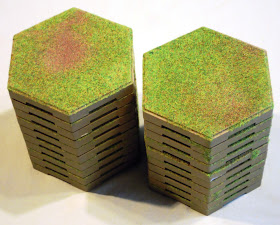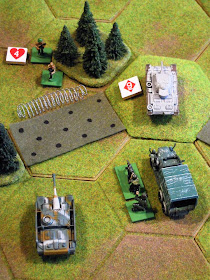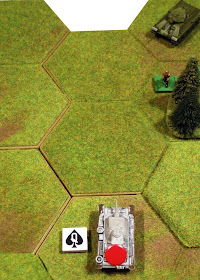After my recent battles using the modified version of my PORTABLE WARGAME: MODERN rules that uses the playing card tiles to determine the order in which units are activated, I decided that I want to play-test the BIG BOARD version of the rules. I set the battle on the borders between Teutonia and Rusland, mainly because I have plenty of eminently useable German and Russian vehicles and troops to hand.
Scenario
Tension had been rising along the border between Teutonia and Rusland, and both sides claimed that the other had been responsible. A 'outrage' had recently taken place on the Teutonian side of the border (a farm had been raided and several cows had been stolen), and the Teutonic government had blamed Rusland 'bandits'. A small mobile column of Teutonic troops had been assembled near the border, and it was ordered to enter Rusland and conductive a punitive raid on several local villages that were supposed to have been used as bases by the 'bandits'. The Rusland border troops had been alerted by reports of troop movements near the border, and had moved into prepared defensive positions.
The Opposing Forces
The Teutonic mobile column comprised:
- 3 Tank Units
- 1 Assault Gun Unit
- 1 Self-propelled Anti-tank Gun Unit
- 1 Infantry Gun Unit
- 2 Infantry Units
- 2 Machine Gun Units
- 1 Commander
- 5 Truck Units
- Exhaustion Point = 6
The Rusland border troops comprised:
- 1 Light Tank Unit
- 1 Tank Unit
- 1 Infantry Gun Unit
- 1 Anti-tank Gun Unit
- 3 Infantry Units
- 2 Light Machine Gun Units
- 1 Commander
- Exhaustion Point = 4
The Terrain
The terrain along the border was mainly flat and featureless, although there were some small hills and woods.
Above: The battlefield as seen from the Teutonia side of the border.
Below: The battlefield as seen from the Rusland side of the border. The prepared defences (mainly minefields and barbed wire) are designed to hinder any advance and channel attackers into areas where the defenders can deal with them.
Turn 1
As the Rusland defenders were under strict order not to instigate any combat, they remained inactive but alert.
The Teutonic troops were under no such restrictions and the leading Teutonic Units – the Tank Units – entered the battlefield in a vee formation.
Turn 2
In obedience to their orders, the Rusland troops did nothing, whilst the Teutonic forces continued their advance.
Turn 3
At this point the leading Teutonic Tank Unit had broken through the outer barbed wire cordon of the Rusland defences and their orders permitted them to take a more active role. Firing on a pre-registered target area, the Rusland Infantry Gun Unit engaged the leading Teutonic Tank Unit ...
... and hit it!
The Teutonic forces continued their relentless advance, but all along the defence line the Rusland troops engaged any Unit that came within range.
The right-hand Teutonic Tank Unit drove into a minefield (and suffered casualties) in order to engage the Rusland Anti-tank Unit ... which it missed!
On the left, the Teutonic Tank Unit that had first broken through the Rusland defence line engaged one of the Rusland Infantry units and inflicted casualties on it.
On the other side of the battlefield the Rusland Anti-tank Gun Unit hit the Teutonic Tank Unit that had just passed through the minefield, forcing to retreat back through it, causing it further casualties.
The Rusland Infantry Unit that had been attacked by the Teutonic Tank Unit counter-attacked, even though they had no anti-tank weapons ... and were forced to retreat without suffering further casualties.
The Teutonic Assault Gun Unit opened fire on the Rusland Machine Gun Unit that was concealed in a small wood, but were unable to cause them any casualties. (
I allowed the Assault Gun to fire as if it were a Tank Unit. This play-test convinced me that the existing rules need to be amended to allow this.)
The Rusland Tank Unit was presented with a very tempting target – a Teutonic Tank Unit – and engaged it ...
... causing it to retreat.
At the end of the turn, the battlefield looked like this:
On the surface things seemed to be going well for the Teutonic troops, but they were already half way to reaching their Exhaustion Point and had yet to totally destroy any of the defending Rusland Units.
Turn 4
The Rusland Infantry Gun Unit opened fire on the nearby Teutonic Truck Unit ...
... which it hit. Furthermore, the Infantry Unit that was being carried by the Truck Unit was also hit and suffered a casualty ... thus bringing the Teutonic troops even closer to their Exhaustion Point!
The Rusland Anti-tank Gun Unit fired at the Teutonic Tank Unit directly in front of, which it hit and destroyed!
At this point the Teutonic force had reached its Exhaustion Point, and from the beginning of the next turn it would not be able to take any offensive action. They were not, however, prevented from doing so this turn.
On the left-hand side of the Teutonic attack, things were going somewhat better for them. Although the Teutonic Assault Gun Unit was unsuccessful in its attack on the Rusland Machine Gun Unit that was in the woods ...
... the Truck-borne Teutonic Machine Gun Unit that dismounted nearby was able to inflict a casualty upon the Rusland Machine Gun Unit.
At the first opportunity the Rusland Machine Gun Unit returned fire ...
... and hit the Teutonic Machine Gun Unit, reducing its strength by 50%.
Nearby the Rusland Tank Unit moved forward and fired on the nearest Teutonic Tank Unit ...
... and missed, as did the Rusland Light Tank Unit when it opened fire on the Teutonic Self-propelled Anti-tank Gun Unit.
The Truck Unit (which still contained a Teutonic Infantry Unit) was too tempting a target for Rusland Machine Gun Unit on the left-hand side of the defences, and they raked the Truck Unit with machine gun fire that inflicted more damage of the Truck Unit (in fact, destroying it) and causing the Unit it was carrying further casualties.
The foremost Teutonic Tank Unit returned fire on the Rusland Tank Unit that had engaged it earlier during the turn, and forced it to withdraw.
In the centre one of the Teutonic Infantry units finally disembarked from the Truck Unit that had been carrying it ...
... whilst the nearby Teutonic Infantry Gun Unit unlimbered and prepared to engage the enemy.
The Rusland Machine Gun Unit that was in the woods on the left of the Teutonic advance was fired on by the right-hand Teutonic Tank Unit ... and suffered no further losses.
At the same time the Teutonic Self-propelled Anti-Tank Gun Unit fired at the Rusland Light Tank Unit and inflicted damage upon it. (
I allowed the Self-propelled Anti-tank Gun Unit to fire as if it were a Tank Unit. This play-test convinced me that the existing rules need to be amended to allow this.)
At the end of the turn the Teutonic force was in a position to exploit a minor breach in the Rusland defences, but the loss of one third of its initial strength meant that it could not take advantage of it.
Turn 5
Neither side's Artillery Units had targets in direct line-of-sight or that they were otherwise able to engage.
The Teutonic troops began to conduct a fighting withdrawal whilst the Rusland troops did as much as they could to harass them. The troublesome Rusland Machine Gun Unit fired at the nearest Teutonic Truck Unit just after the Teutonic Infantry Unit had re-embarked, and caused casualties on both the Truck and Infantry Unit as well as forcing them to withdraw.
This was countered by some ineffective fire from one of the withdrawing Teutonic Tank Units.
On the other side of the battlefield the Teutonic Self-propelled Anti-tank Gun Unit fired at the Rusland Light Tank Unit, forcing it to fall back.
The Teutonic Assault Gun Unit covered its withdrawal by firing at the Rusland Machine Gun Unit directly in front of it ... to no effect.
The Rusland Tank Unit exchanged fire with the foremost Teutonic Tank Unit ...
... but neither Tank Unit was able to inflict damage on the other.
The other Rusland Machine Gun Unit engaged the depleted Teutonic Infantry Unit to its front, and inflict a further casualty on them before they were able to fall back.
At the end of the turn the Teutonic troops were withdrawing in a good an order as they could whilst the Rusland defenders were able to breath a combined sigh of relief that they had just managed to prevail!
Turn 6
The was no further combat because the Rusland troops had been ordered not to pursue the Teutonic troops if they withdrew.
By the end of the turn the only Teutonic troops remaining on the battlefield were the remaining Tank Units, and these were being carefully watched by the Rusland Light Tank Unit.
Comments
This battle was fought over the space of two days and with lots of interruptions. The use of the playing card tiles enabled me to walk away from the battle and return to it hours later without having to worry about remembering which units had or had not moved during the current turn.
From a tactical point of view the Teutonic force should have brought its truck-borne Infantry Units on earlier ... and disembarked the Infantry Units from them earlier so that they could have supported the Tank Units. As it was all the Rusland troops had to do was just sit tight and defeat the Teutonic troops piecemeal.
It became very obvious that self-propelled Artillery needs to be treated more like Tanks that have a restricted gun traverse and not just as Artillery that has a bit more mobility, and the rules will need to be adjusted accordingly.














































































